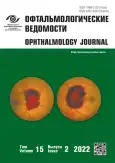Ciclosporin use for prevention of pterygium recurrence
- Authors: Bochkareva A.N.1, Kolenko O.V.1,2, Egorov V.V.1,2, Smoliakova G.P.1,2, Banshchikov P.A.1
-
Affiliations:
- S.N. Fyodorov Eye Microsurgery Federal State Institution, Khabarovsk Branch
- Postgraduate Institute for Public Health Workers
- Issue: Vol 15, No 2 (2022)
- Pages: 19-26
- Section: Original study articles
- URL: https://journals.rcsi.science/ov/article/view/108645
- DOI: https://doi.org/10.17816/OV108645
- ID: 108645
Cite item
Abstract
BACKGROUND: Despite the development of new methods for treatment of pterygium, the frequency of its recurrence ranges from 5 to 89%.
AIM: Was to evaluate the effectiveness of ciclosporin for prevention of pterygium recurrence.
MATERIALS AND METHODS: Under follow-up, there were 104 patients operated for pterygium, of which 26 had a high risk of recurrence, they were divided into 2 groups: the 1st group — 13 patients received 0.05% ciclosporin in addition to basic therapy; the 2nd group — 13 patients receiving only basic therapy. Patients of studied groups were under dynamic observation for 1 year.
RESULTS: After 3 months, all patients of the 1st group showed normalization of the osmolarity of the lacrimal fluid (OLF) and the ocular surface disease index (OSDI). In patients of the 2nd group, elevated values of OLF and OSDI remained characterizing the persistence of an inflammatory reaction signs and a high risk of the disease recurrence, as well as the formation of a hypertrophic scar in 38.5% of cases. In one year after surgery, 3 patients of group 2 had a recurrent pterygium, which required surgical retreatment.
CONCLUSIONS: We obtained results showing a positive effect of ciclosporin use on dynamics of inflammatory reactions of the ocular surface in postoperative period, which made it possible to prevent pterygium recurrence after its surgical treatment in patients with high risk of recurrence.
Keywords
Full Text
##article.viewOnOriginalSite##About the authors
Anna N. Bochkareva
S.N. Fyodorov Eye Microsurgery Federal State Institution, Khabarovsk Branch
Author for correspondence.
Email: naukakhvmntk@mail.ru
ORCID iD: 0000-0002-3575-0894
SPIN-code: 2765-4299
Ophthalmologist
Russian Federation, KhabarovskOleg V. Kolenko
S.N. Fyodorov Eye Microsurgery Federal State Institution, Khabarovsk Branch; Postgraduate Institute for Public Health Workers
Email: naukakhvmntk@mail.ru
ORCID iD: 0000-0001-7501-5571
SPIN-code: 5775-5480
Scopus Author ID: 6506683725
Dr. Sci. (Med.), Director
Russian Federation, Khabarovsk; KhabarovskVictor V. Egorov
S.N. Fyodorov Eye Microsurgery Federal State Institution, Khabarovsk Branch; Postgraduate Institute for Public Health Workers
Email: naukakhvmntk@mail.ru
ORCID iD: 0000-0002-9888-7353
SPIN-code: 9253-3870
Scopus Author ID: 7202505024
Dr. Sci. (Med.), Professor, General Consultant
Russian Federation, Khabarovsk; KhabarovskGalina P. Smoliakova
S.N. Fyodorov Eye Microsurgery Federal State Institution, Khabarovsk Branch; Postgraduate Institute for Public Health Workers
Email: naukakhvmntk@mail.ru
ORCID iD: 0000-0002-6943-5518
SPIN-code: 8667-1885
Scopus Author ID: 6701803515
MD, Dr. Sci. (Med.), Professor, Ophthalmologist
Russian Federation, Khabarovsk; KhabarovskPavel A. Banshchikov
S.N. Fyodorov Eye Microsurgery Federal State Institution, Khabarovsk Branch
Email: naukakhvmntk@mail.ru
ORCID iD: 0000-0002-0854-4104
SPIN-code: 5105-9233
Scopus Author ID: 57201736974
MD, Cand. Sci. (Med.), Head of the Reconstructive Surgery Department, Ophthalmologist
Russian Federation, KhabarovskReferences
- Borodin YuI, Valsky VV, Verigo EN. Late results of combined treatment of recurrent pterigium. Ophthalmology in Russia. 2007;(3):29–33. (In Russ.)
- Bochkareva AN, Egorov VV, Smoliakova GP, et al. Analysis of clinical effectiveness of prophylaxis of recurrent pterygium. Dal’nevostochnyi meditsinskii zhurnal. 2017;(3):44–47. (In Russ.)
- Bochkareva AN, Egorov VV, Smoliakova GP, Banshchikov PA. Vliyanie osmolyarnosti sleznoi zhidkosti na techenie regenerativno-reparativnykh reaktsii v khirurgii pervichnogo pterigiuma. Sovremennye tekhnologii v oftal’mologii. 2015;(2):144–146. (In Russ.)
- Titarenko ZD, Gonchar PF, Titarenko IV. Pterigium (patogenez, klinika, lechenie). Kishinev: Shtiintsa, 1992. 87 p. (In Russ.)
- Dzhashi BG, Serkov YuS. Posleoperatsionnoe vedenie patsientov s retsidiviruyushchim pterigiumom. Sovremennye tekhnologii v oftal’mologii. 2017;(3):40–42. (In Russ.)
- Bilalov EN, Oripov OI, Nozimov AE, Muradmusayev MK. The features of dry eye syndrome in patients with pterigium. Bulletin of Bashkir State Medical University. 2019;(3):42–46. (In Russ.)
- Kalinina NM, Popov VYu, Brzheskiy VV. The role of lacrimal fluid cytokines in the development of dry eye disease (review). Cytokines and inflammation. 2015;14(1):5–10. (In Russ.)
- Aleksandrova SE. Analiz ehffektivnosti preparata restasis u patsientov s sindromom “sukhogo glaza” srednei stepeni tyazhesti. Otrazhenie. 2017;(2):27–28. (In Russ.)
- Germanova VN, Volzhanin AV, Zolotarev AV, et al. Cyclosporine A in glaucoma surgery: perspectives and opportunities. National Journal glaucoma. 2017;16(2):92–100. (In Russ.)
- Maĭchuk DIu, Vasil’eva OA, Shokirova MM. Use of cyclosporine 0.05 % in various ocular surface disorders. The Russian annals of ophthalmology. 2014;130(2):68–71. (In Russ.)
- Riks IA. Cyclosporine use in “dry eye” syndrome. Ophthalmology Journal. 2019;12(3):75–82. (In Russ.) doi: 10.17816/OV15853
- Kunert KS, Tisdale AS, Gipson IP. Goblet cell numbers and epithelial proliferation in the conjunctiva of dry eye syndrome treated with cyclosporine. Arch Ophthalmol. 2002;120(3):330–337. doi: 10.1001/archopht.120.3.330
- Zhigal’skaya TA, Krivosheina OI. Dinamika regeneratsii tkanei glaza v oblasti operativnogo vmeshatelstva posle applikatsii preparata “Restasis”. Sovremennye tekhnologii v oftal’mologii. 2017;(3):124–126. (In Russ.)
- Hirst LW. The treatment of pterygium. Surv Ophthalmol. 2003;48(2):145–180. doi: 10.1016/s0039-6257(02)00463-0
- Safonova TN, Pateiuk LS. Ocular surface system integrity. The Russian annals of ophthalmology. 2015;131(1):96–103. (In Russ.) doi: 10.17116/oftalma2015131196-102
- Vodovozov AM, Petraveskii AV. Izmenenie mikrotsirkulyatsii metodom flyuorestsentnoi angiografii bulbarnoi konyunktivy i limba. Oftal’mologicheskii zhurnal. 1978;(7):484–487. (In Russ.)
- Kiseleva TN, Kotelin VI, Losanova OA, Lugovkina KV. Noninvasive methods assessment blood flow in anterior segment and clinical application perspective. Ophthalmology in Russia. 2017;14(4):283–290. (In Russ.) doi: 10.18008/1816-5095-2017-4-283-290
- Safonova TN, Lutsevich EE, Kintukhina NP. Microcirculatory changes in bulbar conjunctiva in various diseases. The Russian annals of ophthalmology. 2016;132(2):90–95. (In Russ.) doi: 10.17116/oftalma2016132290-95
- Malaya LT, Miklyaev IYu, Kravchun PG. Mikrotsirkulyatsiya v kardiologii. Kharkiv: Visheisha shkola, 1977. 232 p. (In Russ.)
Supplementary files









